View in other NatureServe Network Field Guides
NatureServe
Montana
Utah
Wyoming
Idaho
Wisconsin
British Columbia
South Carolina
Yukon
California
New York
Alkali Marsh Aster - Almutaster pauciflorus
Other Names:
Aster pauciflorus
State Rank Reason (see State Rank above)
Almutaster pauciflorus was first documented in 1988, and is now known from five sites in central and northeastern Montana. It grows in wet meadows or calcareous soil of fens within the plains.
- Details on Status Ranking and Review
Range Extent
ScoreF - 20,000-200,000 sq km (~8,000-80,000 sq mi)
Area of Occupancy
ScoreC - 3-5 4-km2 grid cells
Number of Populations
ScoreA - 1 - 5
Number of Occurrences or Percent Area with Good Viability / Ecological Integrity
ScoreB - Very few (1-3) occurrences with excellent or good viability or ecological integrity
Environmental Specificity
ScoreB - Narrow. Specialist or community with key requirements common
Threats
ScoreU - Unknown
General Description
Plants: A rhizomatous, colony-forming perennial (SEINet 2017). Rhizomes (underground stems) are slender, with “fleshy fibrous roots” (Nesom 2000). Stems are ascending, 12-40 cm tall, with glabrate (almost smooth) herbage. Above, stems are glandular-pubescent (Lesica et al. 2012).
Leaves: Basal leaves are petiolate and the petiole clasps the stem (Semple 2017); they sometimes wither as the plant develops (eFloras 2017). Stem leaves lack a petiole (Semple 2017) and are somewhat clasping (eFloras 2017). Blades are linear, with parallel veins (SEINet 2017). They are 3-12 cm long and entire (Lesica et al. 2012), with a tiny abrupt point (eFloras 2017).
Inflorescence: Usually 3-10 heads (eFloras 2017) in a panicle, with stipitate-glandular peduncles (Lesica et al. 2012) and small, awl-shaped bracts (Cronquist et al. 1994). Heads are radiate (with both disc and ray florets) and have a flat, glabrous receptacle. The involucre is 5-8 mm high and narrowly bell-shaped (Lesica et al. 2012). Involucral bracts overlap in several series (Cronquist et al. 1994) and have translucent margins appearing gnawed (eFloras 2017). The bracts are linear to lanceolate, glandular, and green but sometimes purplish (Lesica et al. 2012).
(Contribution of Lesica et al. adapted from
Lesica et al. 2012. Manual of Montana Vascular Plants. BRIT Press. Fort Worth, TX)
Phenology
Flowers May-September (Cronquist et al. 1994).
Diagnostic Characteristics
A composite flower (family Asteraceae) of fairly specific habitats with glandular upper parts, linear leaves generally less than 1 cm wide, and at least several flowerheads. Similar to Symphyotrichum campestre (Nutt.) G.L. Nesom, but Almutaster pauciflorus differs in its moister, alkaline habitat and less-leafy, longer branches in the inflorescence (Cronquist et al. 1994, eFloras 2017).
Species Range
Montana Range
Range Descriptions
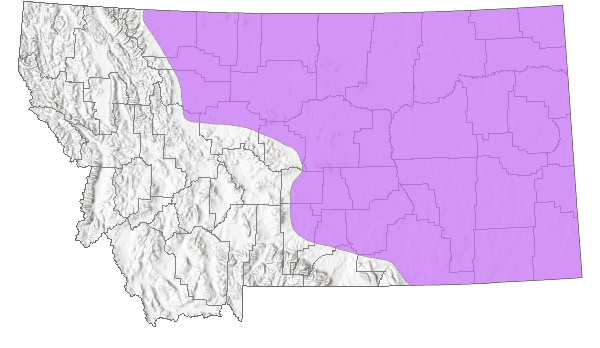
 Native
Native
Range Comments
Northwest Territories south to CA, AZ, NM, TX, and ND (Lesica et al. 2012). In Montana, herbarium specimens exist from Wheatland, Richland, Sheridan, and Valley Counties (CPNWH 2017).
(Contribution of Lesica et al. adapted from Lesica et al. 2012. Manual of Montana Vascular Plants. BRIT Press. Fort Worth, TX)
Observations in Montana Natural Heritage Program Database
Number of Observations: 9
(Click on the following maps and charts to see full sized version)
Map Help and Descriptions
Relative Density
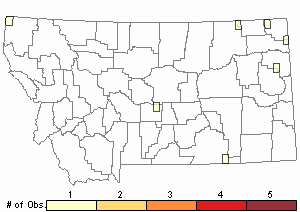
Recency

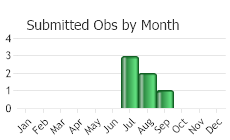
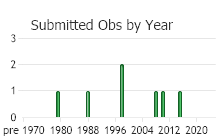
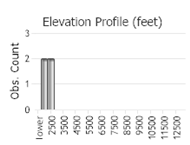 (Observations spanning multiple months or years are excluded from time charts)
(Observations spanning multiple months or years are excluded from time charts)
Habitat
On the plains in wet, usually calcareous soil of fens and wet meadows (Lesica et al. 2012); along streams in dry country (eFloras 2017). Montana specimens have been found in habitats such as shallow wetlands, marshy areas, springs, river-associated meadows, and short grass prairie (CPWNH 2017).
(Contribution of Lesica et al. adapted from
Lesica et al. 2012. Manual of Montana Vascular Plants. BRIT Press. Fort Worth, TX)
National Vegetation Classification System Groups Associated with this Species
Wetland and Riparian
Wet Meadow and Marsh
Ecology
A halophytic plant - associated with alkaline flats, habitats with clay soils, high evaporation, and seasonal inundation with a distinctive flora (Culver and Lemly 2013). In southeastern Arizona, this plant is only known to occur in rare, marshy, alkaline habitats called cienagas, where it is found with other halophytes and has been considered an indicator species due to its fidelity to this type of habitat (Makings 2013). Considered a Facultative-Wet plant in Montana by the US Army Corps of Engineers – usually but not always found in wetlands (Lesica and Husby 2015). Alberta Environment and Sustainable Resource Development considers seed dispersal weak, on a scale from very weak to very strong (Barber 2015).
The subfamily Asteroideae, to which Almutaster pauciflorus belongs, produces substantial quantities of accessible pollen and nectar. A study of pollen collecting by 60 species of bees in the genus Colletes revealed the Asteroideae as a group was a very important pollen resource (Muller and Kuhlmann 2008). However, predominately specialist bees gathered Asteroideae pollen, while generalist species used it in minor quantities. This corroborates other research finding a tendency towards specialized bee pollination in the Asteroideae. The pollen may have protective chemicals or low protein content, making it difficult for generalist bees to use it.
Reproductive Characteristics
Flowers: Each head has 15 to 30 female ray flowers, which are white to pale blue and have 5-10 mm long ligules (flattened parts of corollas). There are 40 to 50 perfect (with male and female parts) disk flowers, which are pale yellow and have roughly 5 mm long corollas (Lesica et al. 2012).
Fruit: Achenes are sparsely hairy, obconic, and roughly 1 mm long, with 7 to 10 veins (Lesica et al. 2012). They are golden-brown and are topped with a pappus (modified calyx) of numerous capillary bristles (eFloras 2017).
(Contribution of Lesica et al. adapted from
Lesica et al. 2012. Manual of Montana Vascular Plants. BRIT Press. Fort Worth, TX)
Management
Coefficient of Conservatism rating of 7: intolerant of disturbance (Pipp 2015).
Stewardship Responsibility
Threats or Limiting Factors
STATE THREAT SCORE REASON
Threat impact not assigned because threats are not known (MTNHP Threat Assessment 2021).
References
- Literature Cited AboveLegend:
 View Online Publication
View Online Publication Barber, Q.E.C. 2015. Assessing the vulnerability of rare plants using climate change velocity, habitat connectivity and dispersal ability. M. Sc. Thesis. Edmonton: Department of Renewable Resources, University of Alberta. 91 p.
Barber, Q.E.C. 2015. Assessing the vulnerability of rare plants using climate change velocity, habitat connectivity and dispersal ability. M. Sc. Thesis. Edmonton: Department of Renewable Resources, University of Alberta. 91 p. Cronquist, A., A.H. Holmgren, N.H. Holmgren, J.L. Reveal, and P.K. Holmgren. 1994. Intermountain Flora: Vascular Plants of the Intermountain West. Asterales. U.S.A., Volume 5. Published for The New York Botanical Garden, Bronx, New York.
Cronquist, A., A.H. Holmgren, N.H. Holmgren, J.L. Reveal, and P.K. Holmgren. 1994. Intermountain Flora: Vascular Plants of the Intermountain West. Asterales. U.S.A., Volume 5. Published for The New York Botanical Garden, Bronx, New York. Culver, D. and J. Lemly. 2013. Field Guide to Colorado's Wetland Plants: Identification, Ecology and Conservation. Fort Collins, CO: Colorado Natural Heritage Program. 694 p.
Culver, D. and J. Lemly. 2013. Field Guide to Colorado's Wetland Plants: Identification, Ecology and Conservation. Fort Collins, CO: Colorado Natural Heritage Program. 694 p. eFloras. 2017. Flora of North America. Missouri Botanical Garden, St. Louis, MO & Harvard University Herbaria, Cambridge, MA.
eFloras. 2017. Flora of North America. Missouri Botanical Garden, St. Louis, MO & Harvard University Herbaria, Cambridge, MA. Lesica, P. and P. Husby. 2015. Field Guide to Montana's Wetland Vascular Plants, second ed. Helena: Montana Department of Environmental Quality Wetland Program. 119 p.
Lesica, P. and P. Husby. 2015. Field Guide to Montana's Wetland Vascular Plants, second ed. Helena: Montana Department of Environmental Quality Wetland Program. 119 p. Lesica, P., M.T. Lavin, and P.F. Stickney. 2012. Manual of Montana Vascular Plants. Fort Worth, TX: BRIT Press. viii + 771 p.
Lesica, P., M.T. Lavin, and P.F. Stickney. 2012. Manual of Montana Vascular Plants. Fort Worth, TX: BRIT Press. viii + 771 p. Makings, E. 2013. Flora and Vegetation of the Saint David and Lewis Springs Cienegas, Cochise County, Arizona. pp. 71-76 in Gottfried, Gerald J.; Ffolliott, Peter F.; Gebow, Brooke S.; Eskew, Lane G.; Collins, Loa C. Merging science and management in a rapidly changing world: Biodiversity and management of the Madrean Archipelago III and 7th Conference on Research and Resource Management in the Southwestern Deserts; 2012 May 1-5; Tucson, AZ. Proceedings. RMRS-P-67. Fort Collins, CO: U.S. Department of Agriculture, Forest Service, Rocky Mountain Research Station.
Makings, E. 2013. Flora and Vegetation of the Saint David and Lewis Springs Cienegas, Cochise County, Arizona. pp. 71-76 in Gottfried, Gerald J.; Ffolliott, Peter F.; Gebow, Brooke S.; Eskew, Lane G.; Collins, Loa C. Merging science and management in a rapidly changing world: Biodiversity and management of the Madrean Archipelago III and 7th Conference on Research and Resource Management in the Southwestern Deserts; 2012 May 1-5; Tucson, AZ. Proceedings. RMRS-P-67. Fort Collins, CO: U.S. Department of Agriculture, Forest Service, Rocky Mountain Research Station. MTNHP Threat Assessment. 2021. State Threat Score Assignment and Assessment of Reported Threats from 2006 to 2021 for State-listed Vascular Plants. Botany Program, Montana Natural Heritage Program, Helena, Montana.
MTNHP Threat Assessment. 2021. State Threat Score Assignment and Assessment of Reported Threats from 2006 to 2021 for State-listed Vascular Plants. Botany Program, Montana Natural Heritage Program, Helena, Montana. Muller, A. and M. Kuhlmann. 2008. Pollen hosts of western palaearctic bees of the genus Colletes (Hymenoptera: Colletidae): the Asteraceae paradox. Biological Journal of the Linnean Society 95:719-733.
Muller, A. and M. Kuhlmann. 2008. Pollen hosts of western palaearctic bees of the genus Colletes (Hymenoptera: Colletidae): the Asteraceae paradox. Biological Journal of the Linnean Society 95:719-733. Nesom, G.L. 2000. Generic conspectus of the tribe Astereae (Asteraceae) in North America, Central America, the Antilles, and Hawaii. Sida, Bot. Miscellany 20: i-viii, 1–100.
Nesom, G.L. 2000. Generic conspectus of the tribe Astereae (Asteraceae) in North America, Central America, the Antilles, and Hawaii. Sida, Bot. Miscellany 20: i-viii, 1–100. Pipp, A. 2015. Coefficient of Conservatism Rankings for the Flora of Montana: Part I. Report to the Montana Department of Environmental Quality, Helena, Montana. Prepared by the Montana Natural Heritage Program, Helena, Montana. 73 pp.
Pipp, A. 2015. Coefficient of Conservatism Rankings for the Flora of Montana: Part I. Report to the Montana Department of Environmental Quality, Helena, Montana. Prepared by the Montana Natural Heritage Program, Helena, Montana. 73 pp. Semple, J. 2017. Almutaster pauciflorus, in Jepson Flora Project (eds.) Jepson eFlora, accessed on June 22, 2017.
Semple, J. 2017. Almutaster pauciflorus, in Jepson Flora Project (eds.) Jepson eFlora, accessed on June 22, 2017. Southwest Environmental Information Network, SEINet - Arizona Chapter. 2017. Accessed on June 22.
Southwest Environmental Information Network, SEINet - Arizona Chapter. 2017. Accessed on June 22.
- Additional ReferencesLegend:
 View Online Publication
View Online Publication
Do you know of a citation we're missing? Consortium of Pacific Northwest Herbaria (CPNWH) Specimen Database. No Date. Plant specimen data displayed on the PNW Herbaria portal. Website http://www.pnwherbaria.org.
Consortium of Pacific Northwest Herbaria (CPNWH) Specimen Database. No Date. Plant specimen data displayed on the PNW Herbaria portal. Website http://www.pnwherbaria.org. Lesica, P., M.T. Lavin, and P.F. Stickney. 2022. Manual of Montana Vascular Plants, Second Edition. Fort Worth, TX: BRIT Press. viii + 779 p.
Lesica, P., M.T. Lavin, and P.F. Stickney. 2022. Manual of Montana Vascular Plants, Second Edition. Fort Worth, TX: BRIT Press. viii + 779 p. Whitehead, B.K. 2020. The response of parafluvial soils to beaver mimicry restoration in a montane stream. M.Sc. Thesis. Bozeman, MT: Montana State University. 114 p.
Whitehead, B.K. 2020. The response of parafluvial soils to beaver mimicry restoration in a montane stream. M.Sc. Thesis. Bozeman, MT: Montana State University. 114 p.
- Web Search Engines for Articles on "Alkali Marsh Aster"





